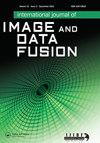A Robust Unscented Kalman Filter applied to Ultra-wideband Positioning
IF 1.8
Q3 REMOTE SENSING
International Journal of Image and Data Fusion
Pub Date : 2020-09-22
DOI:10.1080/19479832.2020.1813816
引用次数: 2
Abstract
ABSTRACT Ultra-wideband (UWB) is well suited for indoor positioning due to its high resolution and good penetration through objects. As one of nonlinear filter algorithms, unscented Kalman filter (UKF) is widely used to estimate the position. However, UKF cannot resist the effect of outliers. The performance of the filter algorithm will be inevitably influenced. In this study, a robust UKF (RUKF) method accompanied by hypothesis test and robust estimation is proposed. Furthermore, the simulation and measurement experiments are performed to verify the effectiveness and feasibility of the proposed RUKF. Simulation experiment results are given to demonstrate that the RUKF can effectively control the influences of the outliers being treated as systematic errors and large variance random errors. When the outliers come from the thick-tailed distribution, the robust estimation does not play a role, and the RUKF does not work well. The measured experiment results show that the outliers will be generated in the non-line-of-sight environment whose impact is abnormally serious. The robust estimation can provide relatively reliable optimised residuals and control the influences of the outliers caused by gross errors. We can believe that the proposed RUKF is effective to resist the effects of outliers and improves the positioning accuracy.一种鲁棒无气味卡尔曼滤波在超宽带定位中的应用
超宽带(UWB)以其高分辨率和良好的穿透性而非常适合于室内定位。无气味卡尔曼滤波(UKF)作为一种非线性滤波算法,被广泛用于位置估计。然而,UKF无法抵抗异常值的影响。这将不可避免地影响滤波算法的性能。本文提出了一种伴随假设检验和稳健估计的鲁棒UKF (RUKF)方法。通过仿真和测量实验验证了该算法的有效性和可行性。仿真实验结果表明,RUKF可以有效地控制被视为系统误差和大方差随机误差的离群值的影响。当异常值来自厚尾分布时,鲁棒估计不起作用,RUKF不能很好地工作。实测实验结果表明,在影响异常严重的非视距环境中会产生异常值。鲁棒估计可以提供相对可靠的优化残差,并控制粗误差引起的异常值的影响。我们可以认为,所提出的RUKF能够有效地抵抗离群值的影响,提高定位精度。
本文章由计算机程序翻译,如有差异,请以英文原文为准。
求助全文
约1分钟内获得全文
求助全文
来源期刊

International Journal of Image and Data Fusion
REMOTE SENSING-
CiteScore
5.00
自引率
0.00%
发文量
10
期刊介绍:
International Journal of Image and Data Fusion provides a single source of information for all aspects of image and data fusion methodologies, developments, techniques and applications. Image and data fusion techniques are important for combining the many sources of satellite, airborne and ground based imaging systems, and integrating these with other related data sets for enhanced information extraction and decision making. Image and data fusion aims at the integration of multi-sensor, multi-temporal, multi-resolution and multi-platform image data, together with geospatial data, GIS, in-situ, and other statistical data sets for improved information extraction, as well as to increase the reliability of the information. This leads to more accurate information that provides for robust operational performance, i.e. increased confidence, reduced ambiguity and improved classification enabling evidence based management. The journal welcomes original research papers, review papers, shorter letters, technical articles, book reviews and conference reports in all areas of image and data fusion including, but not limited to, the following aspects and topics: • Automatic registration/geometric aspects of fusing images with different spatial, spectral, temporal resolutions; phase information; or acquired in different modes • Pixel, feature and decision level fusion algorithms and methodologies • Data Assimilation: fusing data with models • Multi-source classification and information extraction • Integration of satellite, airborne and terrestrial sensor systems • Fusing temporal data sets for change detection studies (e.g. for Land Cover/Land Use Change studies) • Image and data mining from multi-platform, multi-source, multi-scale, multi-temporal data sets (e.g. geometric information, topological information, statistical information, etc.).
 求助内容:
求助内容: 应助结果提醒方式:
应助结果提醒方式:


